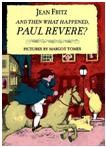 |
| Paul Revere by John Singleton Copley, 1768 |
In the spring of 1775, Boston silversmith Paul Revere was working as an express rider, carrying messages and news across the colonial countryside. As darkness fell on April 18, a physician asked Revere to travel to Lexington, Massachusetts, to deliver an urgent message: British troops would be marching that night to arrest fellow patriots Samuel Adams and John Hancock-- and those troops also meant to seize weapons from colonial militia. Revere quickly made his way across the Charles River and, after confirming that the Sons of Liberty society had spotted pre-arranged lantern signals in a church bell tower, he borrowed a friend's horse and started his ride to Lexington.
Along the way, Revere warned sleepy colonists of the British advance before arriving in Lexington around midnight. After delivering his message to Adams and Hancock, Revere was joined by William Dawes (a second rider who had been sent by another route) and then by a third rider, Dr. Samuel Prescott. All three were arrested that night and held for a time by British troops. Left without a horse after his release, Revere found his way back to Lexington and witnessed part of the historic battle on Lexington Green.
In the nineteenth century, American poet Henry Wadsworth Longfellow rescued the silversmith patriot's dramatic story from the shadows of history and wrote the well-known and widely-read poem, Paul Revere's Ride. Today, Poetry on Parade celebrates Paul Revere's now-famous ride with the opening lines of Henry Wadsworth Longfellow's long-famous poem:
Listen,my children, and you shall hear
Of the midnight ride of Paul Revere,
On the eighteenth of April, in Seventy-Five;
Hardly a man is now alive
Who remembers that famous day and year.
Of the midnight ride of Paul Revere,
On the eighteenth of April, in Seventy-Five;
Hardly a man is now alive
Who remembers that famous day and year.
He said to his friend, "If the British march
By land or sea from the town to-night,
Hang a lantern aloft in the belfry arch
Of the North Church tower, as a signal light, --
One, if by land, and two, if by sea;
And I on the opposite shore will be,
Ready to ride and spread the alarm
Through every Middlesex village and farm,
For the country-folk to be up and to arm...."
We can learn more about Paul Revere's ride and Longfellow's poem in the LMC:
This popular Battle of the Books Biography shares well-known facts and lesser-known details of Paul Revere's life and exciting midnight ride.
P LON The Midnight Ride of Paul Revere by Henry Wadsworth Longfellow; graved and painted by Christopher Bing.
You'll find this beautifully illustrated edition of Longfellow's famous poem in the LMC Picture Book Collection.
811 LON Paul Revere's Ride: The Landlord's Tale by Henry Wadsworth Longfellow; ill. by Charles Santore.
811 LON Paul Revere's Ride: The Landlord's Tale by Henry Wadsworth Longfellow; ill. by Charles Santore.
This book from the LMC Poetry Collection presents an illustrated version of Henry Wadsworth Longfellow's long poem.
973.3 NIZ Paul Revere's Ride by Xavier Niz; ill. by Brian Bascle.
973.3 NIZ Paul Revere's Ride by Xavier Niz; ill. by Brian Bascle.
You'll find this colorful graphic novel account of Paul Revere's famous ride to warn Samuel Adams and John Hancock of danger-- and to alert fellow colonists of trouble-- in the Non Fiction History Collection.
It's about a man, a horse, a poet, and a poem: the rest, as they say, is history.
It's about a man, a horse, a poet, and a poem: the rest, as they say, is history.
Happy Paul Revere's Ride Day, Poetry Paraders!






No comments:
Post a Comment